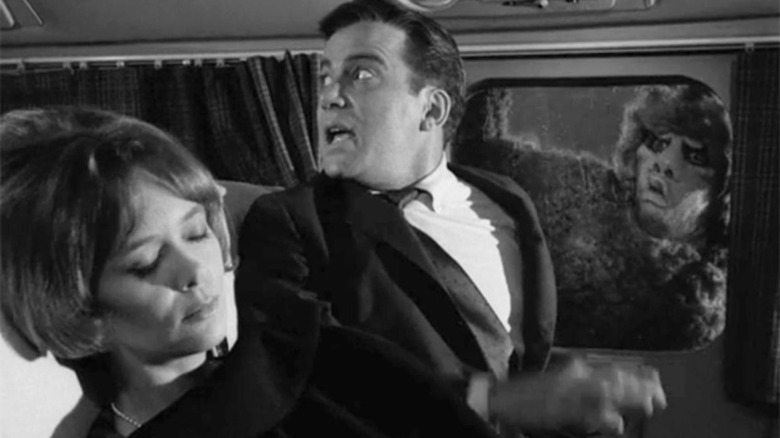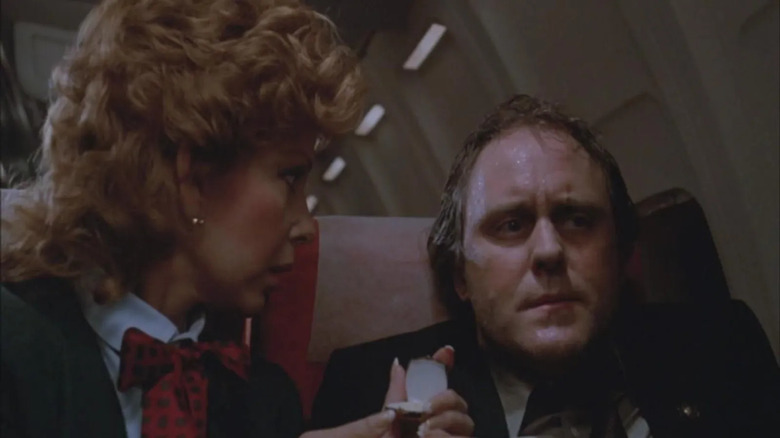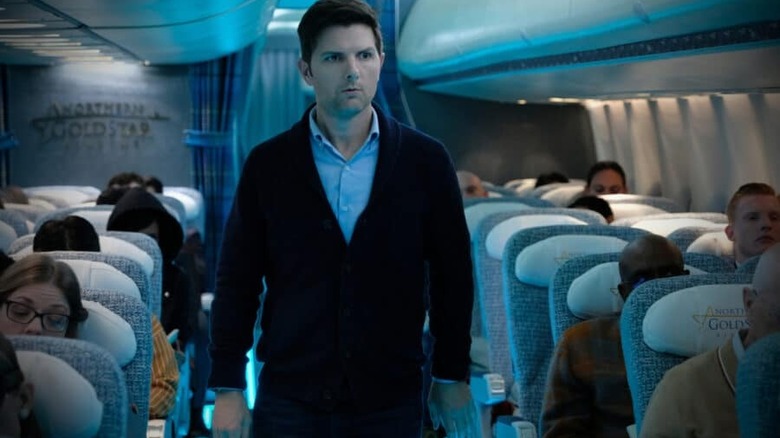They Remade A Classic Twilight Zone Episode Twice – But The Original Tops Them All
The "Twilight Zone" episode "Nightmare at 20,000 Feet" (October 11, 1963), directed by Richard Donner, remains to this day one of the show's most popular. Scripted by Richard Matheson and starring a pre-"Star Trek" William Shatner, "Nightmare" follows a man, Robert Wilson, recently released from a sanitarium due to a mental breakdown. On a flight back home, Robert peers out the plane window into the rainy night and sees a massive, furry gremlin standing on the wing of the plane. The gremlin, in true gremlin spirit, pries up a metal panel on the wing and begins futzing with the machinery inside. The gremlin might very well cause the plane to crash. When Robert tries to alert anyone about the gremlin, they all assume he's imagining it, once again succumbing to his nerves.
Matheson first conceived of "Nightmare" in a 1961 short story, published in his anthology "Alone By Night." The story has become a seminal chapter in sci-fi TV history and "There's a man on the wing of the plane!" has become pop vernacular for extreme Cassandra-adjacent panic. Matheson said he liked the televised version of "Nightmare," although he did once say at a live Q&A (which this author was lucky enough to attend) that he didn't like the monster. He felt it looked like a big cuddly panda bear.
"Nightmare at 20,000 Feet" became so integral to "The Twilight Zone" that it was selected to be remade in 1983 as the finale segment of "Twilight Zone: The Movie." George Miller directed the segment. Then, when "The Twilight Zone" was rebooted in 2019 on CBS All Access, "Nightmare" was remade again starring Adam Scott and with a drastically altered story.
Neither of the remakes, however, captures the trim, terrifying simplicity of the original.
The George Miller version
Director George Miller is best known for his wild and energetic directing style, and his films tend to be fast-paced and wildly stylistic. Miller is the man behind the "Mad Max" movies, "The Witches of Eastwick," and "Babe: Pig in the City." He won an Academy Award for his animated film "Happy Feet." Needless to say, when Miller adapted "Nightmare at 20,000 Feet" to the big screen, it was wildly stressful, quickly cut, and far more panicked than the version starring William Shatner. John Lithgow stepped into the lead role and he began the segment already panicking, pouring sweat, and worrying those around him.
Matheson, at the same Q&A mentioned above, noted that Lithgow played the part entirely wrong. Shatner, he felt, was a nervous man who slowly built himself into a panicked frenzy. It was the kind of performance the story required. Lithgow, in contrast, started in a panicked frenzy. There was no build-up of tension in Miller's version. There was just sweat and terror. One might argue that there is a horror movie-like integrity to that approach, but it didn't necessarily improve upon the trim efficiency of the original "Nightmare."
Indeed, one might say that "Twilight Zone: The Movie" didn't add much of anything to the "Twilight Zone" canon. It merely reworked some of the show's classic episodes filtered through the modern blockbuster sensibility of Miller, Steven Spielberg, Joe Dante, and John Landis. Dante's wild, cartoonish segment added a lot of surreal, visual flare to the original, but the story remained fundamentally unaltered. And, of course, Landis' notorious mishandling of his segment led to multiple deaths. There aren't too many reasons to watch "Twilight Zone: The Movie."
The 2019 version
When Jordan Peele rebooted "The Twilight Zone" for CBS All Access in 2019, he wanted to kick it off with at least one semi-familiar story to let viewers know that he could handle a celebrated sci-fi legacy. But Peele, working with Simon Kinberg and teleplay writer Marco Ramirez, conceived an absurd, largely ridiculous version of "Nightmare" that altered the premise into something infinitely less interesting.
The 2019 version starred Adam Scott as a journalist named Justin. Rather than seeing someone on the wing of the plane, however, he finds a haunted MP3 player in his seat pocket. The MP3 player plays a podcast that relates the mystery of Flight 1015, a plane that crashed. Justin realizes that he's on flight 1015 right now! The podcast seems to be predicting what will happen.
Justin, without finishing the podcast, tries to prevent the crash by breaking into the cockpit but, naturally, ends up becoming the cause of it. The episode ends with him and the other passengers surviving the crash, although the podcast soon informs him that he will be the only victim. The other survivors then beat him to death.
One can see Peele's attempts to update "Nightmare" to be relevant to modern air travel. Matheson's version, after all, was based on WWII rumors that any malfunctioning airplanes were ruined by unseen gremlin creatures. Those rumors are no longer well-known in 2019. What do people do on planes now? They listen to true-crime podcasts. The episode's writers were clearly trying to "hip up" Matheson's old premise but failed miserably.
The episode is not tense and the new premise is just silly. The original was so great and efficient, it's a pity that some feel an update was necessary. They were not. We were good back in 1963.


